Dryad’s Saddle
The largest capped mushroom in the UK starting early in the year with the season sometimes lasting well into Autumn.
| Mushroom Type | |
| Common Names | Dryad's Saddle (EN), Pheasant's Back (US), Scaly Polypore (US), Cyfrwy Cennog (EN), Żagwiak Łuskowaty (PL), Pisztricgomba (HU) |
| Scientific Name | Cerioporus squamosus |
| Synonyms | Polyporus squamosus |
| Season Start | May |
| Season End | Aug |
| Average Mushroom height (CM) | 6-10 |
| Average Cap width (CM) | 20-40 |
Cap
20-40cm but can sometimes be found much larger. A large circular or fan shaped bracket. Ochre to dark yellow with darker, concentric circles of brown scales.
Stem
A woody lateral stem up to 8cm long and 5cm wide but tapering towards the darkening to black base.
Flesh
White, thick and succulent when young becoming leathery then corky as it matures.
Possible Confusion
It would be difficult to confuse this mushroom with any other.
Spore Print
White. Ellipsoid.
Taste / Smell
A bit like water melon when young, fresh and raw but mushroomy when cooked or dried and powdered for stock.
Frequency
Common.
Other Facts
This is the largest capped mushroom in the UK and can become so heavy it can no longer support itself and will fall from it’s position and be found unattached at the base of it’s host tree. Although this mushroom is edible fresh I prefer it dried and powdered to make a good mushroom stock and as it can be so large a lot of stock can be gathered.



 (93 votes, average: 3.72 out of 5)
(93 votes, average: 3.72 out of 5)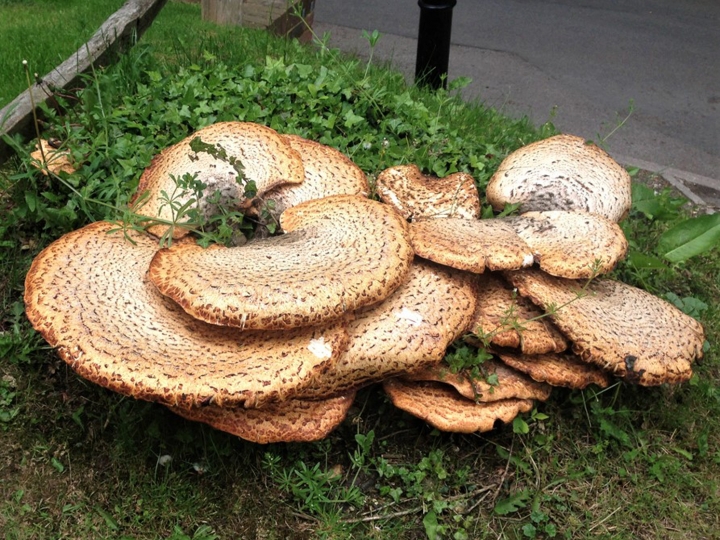















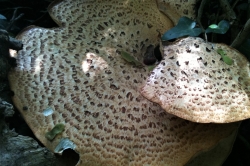
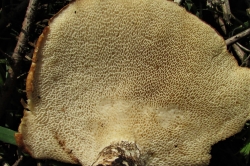
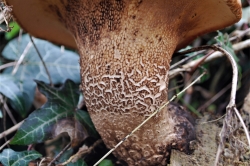
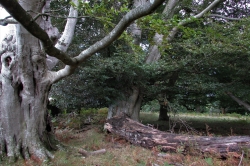






31 comments for Dryad’s Saddle
Are the spors poisonous?
Hi Noah, the spores of an edible mushroom are not normally poisonous (except the Puffball family whose spores can be dangerous if inhaled).
Does this occur in the northwest of the UK or is it more southern areas? Thanks.
I have found them in the Northwest and in Scotland so you should be able to find some later in the year.
Thankyou for your advice. I found one in the woods today. It was enormous quite possibly bigger than 60cm.
Hi, I think I found some of these today growing around the base of a tree, the only difference is the gills, the ones I found appear to have gills underneath, is it the same mushroom? Thanks
If they have gills they are not Dryads Saddles.
Hi, I live in northeast Scotland, 8 years ago we felled a sycamore tree that was too near our back door, in the last two years have been enjoying dryad’s for breakfast with the egg and bacon. Delicious, appear in mid April…
Just found some near Broughton Woods, near Brigg, North Lincolnshire on a family walk out. Thought I’d let any nearby foragers know!
Infound a tree loads of them today. They are not young anymore but not spoiled yet. They were quite dry and rather hard so I left them. As I see them recommended as a powder in stocks, I wondered if these could still have been used.
As long as they look and smell ok they can be dried and turned into stock.
hello from wales,
i’ve just found a sick ash tree with massive dryad’s saddle brackets around the base. (this means whit rot for the tree apparently.)
i’m going to try drying this for stock. it’s a great idea. thanks.
also wondering if anyone has any hints for what to do with the fresh mushroom? recipes or experiences?
have found lots of lovely ‘chicken of the woods’ recently on lovely old oak trees. it’s better than chicken!
Fresh Dryads Saddle can be used in soups or stews or very young ones might work in a fruit salad as the very young specimens taste like watermelon.(I haven’t tried it with other fruit myself)
Found one in north Newcastle upon Tyne. How do you suggest I dry it?
Slice the mushroom into 3-4mm slices and place on a rack if possible in a warm place with some air movement. A fan helps and is probably better than heat
Send photos of the cap, stem, underside and where it is growing to [email protected][email protected][email protected]
Send photos of the cap, stem, underside and where it is growing to [email protected]
I’ve just found 3 massive ones growing out of a tree took the smaller one home cleaned cut into strips and fried with salt and pepper. delicious and meaty
Today discovered many in Berlin Germany growing on a tree near where I live .They have no gills and some are very large like plates ..On other side of the tree smaller specimens are growing Tomorrow will measure the diameter and take photos to show the size ( in a comparative way ) So one can only make stock or pickle such .
Found some st Lawrence Isle of Wight 🙂 going to dry and turn in powder as will be tough as an old boot. How long can I keep the powder for? Thank you. Phil
If it is properly dried and sealed in an airtight jar the powder will last for years.
Hi, we found these in a small wooded area in North Yorkshire, but when we checked out our Collins Guide it advised not to be eaten, can effect health adversely or is deadly?!
Some mushrooms that grow on trees can cause a reaction in some people, usually just vomiting and diarrhea.
We have some of these growing on our old,sick horse chestnut tree. They are a little old now. Can I dry them in a dehydrator?
if they are a little old they are best dried and powdered to use as stock.
Is it unusual to find these mushrooms in September? There are fresh growths of Dryad’s saddle on an Ash stump in my garden in Dublin. They are growing large as the mushrooms of May rot and fall away from the stump.
Fergus
Depending on weather, Dryads Saddles can grow from Spring to late Autumn.
I went looking for these a few weeks ago (i.e. May 2022) having found something to do with them in The Noma Guide to Fermentation. Making a Shoyu (p349) was a bit too complicated for me, but I was so please to find something that I had been looking for. So, I decided to slice thinly, dry and powder for stock.
My oven is good to holding a temperature of 45-50C, so I thought that everything was going well. After 15 mins the smell was very bad and after 30 mins we removed them from the oven and evacuated the house due to the smell.
The pores were open, so not as young as possible. The other one that I found couldn’t be cut by my knife, so I had thought I had harvested a young(ish) one.
Everything that I have read says that these can be really good, but I guess that it can be a bit hit or miss.
I stumbled upon this a few days ago.. it’s huge! I’m in Ayrshire, Scotland. I have photos I can share if you wish.
We think we have found a group of these on a stump but are wary because we are unsure of identification. Pity we cant post a photo. We are in Oakham Rutland.
You can send photos to ID to [email protected]. Please include photos of the stem, cap and gills and where they were growing and any smells detected.